The Prussian hussars were of awerage height and rode on smaller but agile horses.
If they were not as disciplined and trained as dragoons and not as strong and robust
as the cuirassiers, the hussars were the most dashing. They participated in many bold
actions, went through the most difficult situations, and they also skirmished, scouted and pursued
the enemy. From 25 to 29 June 1815 (several days after Waterloo)
two regiments of Prussian hussars had ridden a total of 170 km and since 15 June they
had been marching and fighting almost continuously, which was taking its toll
both on men and horses.
In 1806 were 10 hussar regiments, in 1812 only six.
- The (12th) Hussar Regiment was formed from
two Saxon hussar regiments and militia.
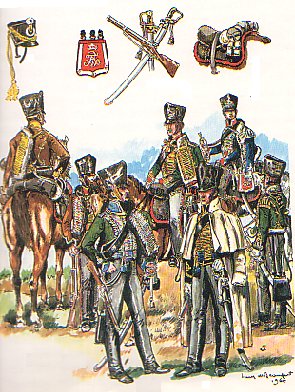 The Prussian hussars were armed with curved sabers and carbines. Pistols were carried by NCOs
and trumpeters.
The Prussian hussars were armed with curved sabers and carbines. Pistols were carried by NCOs
and trumpeters.
Hussars' uniforms were the most expensive and gave them an advantage when it came to
conquering women's hearts :-)
Until 1806 the officers of Guard hussars on parade wore
red-lined panther skins. During campaign however the hussars wore grey overalls over
their tight breeches, the black shako was protected by a black oilcloth.
The sabretache was of brown leather and having a flap with a poppy red cover. The waist
sashes were of the same color as the dolman collar. Officers wore silver-and-black sashes.
The hussars used black sheepskin saddle cloth with a poppy red "wolf's teeth" trim.
These items were replaced in 1815 by rounded saddle cloth with pointed corners.
The dolman and pelisse were in the same color.
The pelisse of the hussars had white fur, but black for the Normal-Husaren-Eskadron.
In 1815, pelisses of the 2. Leib-Husaren-Regiment [No. 2 in the army list], as well as the 7.,
8., 9., 10. and 12. Regiment also got black fur. NCOs had black fur, but this was changed
in 1815 and from that year onwards their fur was of the same colour as that of the men.
Officers had grey "Baranken" (fur of Russian lambs). In 1815 in those of regiments
with black fur the fur of officers became black, too, the officers in the white fur
regiments retaining the "Baranken".
After 1808 other hussar regiments had no shoulder straps, except their officers.
The official regulations issued in December 1808 stated that the sabretache of the
Pommeranian and the 1st and 2nd Life Hussars would be of black leather.
The regimental history of the Life Hussars by Mackensen confirms the black sabretache.
Some illustrators incl. Herbert Knotel, however depict the sabretache of Life Hussars as
covered with red cloth. (Herbert Knötel is considered as generally less reliable than his father Richard.)
The uniforms of 1st and the 2nd Life Hussars were quite similar until 1815.
The only difference was that the 1st had white and
the 2nd had poppy-red shoulder-straps.
In March 1815 the 1st Life Hussars retained the poppy-red facings
(collar, cuffs, stripes etc.), while the 2nd Life were given
black.
|
Uniforms of Prussian hussars in 1815
| Regiment |
Dolman & Pelisse |
Collar & Cuffs |
Buttons & Cords |
Saddle
Cloth |
Stripes
(on saddle cloth) |
1. Life
"Death's Head" |
Black |
Poppy
Red |
White |
Black |
Poppy
Red |
| 2. Life |
Black |
Black |
White |
Black |
Black |
| 3. Brandenburgian |
Dark
Blue |
Poppy
Red |
White |
Dark
Blue |
Poppy
Red |
| 4. 1st Silesian |
Brown |
Brown |
Yellow |
Brown |
Yellow |
| 5. Pomeranian |
Dark
Blue |
Dark
Blue |
Yellow |
Dark
Blue |
Dark
Blue |
| 6. 2nd Silesian |
Green |
Poppy
Red |
Yellow |
Green |
Poppy
Red |
| 7. |
Black |
Poppy
Red |
Yellow |
Black |
Poppy
Red |
| 8. |
Dark
Blue |
Light
Blue |
Yellow |
Dark
Blue |
Light
Blue |
| 9. |
Corn
Blue |
Corn
Blue |
Yellow |
Corn
Blue |
Corn
Blue |
| 10. |
Green |
Light
Blue |
Yellow |
Green |
Light
Blue |
| 11. |
Green |
Poppy
Red |
White |
Green |
Poppy
Red |
| 12. |
Corn
Blue |
Corn
Blue |
White |
Corn
Blue |
Corn
Blue |
|
Death's Head's Hussars
"Totenkopf-Husaren"
The black-clad hussars struck fear
into the enemy for many years.
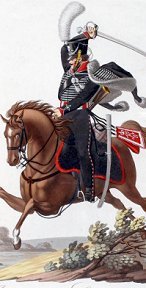 One regiment stood out above the others. It dressed in black and took as its badge a skull.
The regiment became known as the Death's Head Hussars and struck fear into the enemy for
many years. It was the 1st Life Hussar Regiment (1. Leib-Husaren-Regiment)
One regiment stood out above the others. It dressed in black and took as its badge a skull.
The regiment became known as the Death's Head Hussars and struck fear into the enemy for
many years. It was the 1st Life Hussar Regiment (1. Leib-Husaren-Regiment)
The chefs of this unit were:
1804-1808 von Prittwitz
1808-1840 His Majesty Friedrich Wilhelm III
The commanders were:
1803 - Lossow
1806 - Pfuhl
1809 - von Czerdaheli
1812 - Sandrart
The 1st Life Hussar Regiment participated in record number of combats: 66 !
1806 - Drobin, Sierps, Biezun, Mlawa u. Soldau, Lahna, 1807 - Schippenbeil, Lennenburg, Waltersdorf, Wackern, Eylau, Braunsberg, Wusen (Vorpost.), Albrechtsdorf, Danzig (Gdansk), Spanden, Dietrichsdorf, Heilsberg, Gollau and Königsberg, 1812 (as Hus. R. Nr. 1 under Major von Cosel) - Poniewiesz, Borusk (Bobrujsk ?), Wyszki (part of regiment), Czeszawen, Garossenkrug (part of regiment), Neugut (part of regiment), Schöppingsmühle and Baldohnen, Neumühle (part of regiment) and Friedrichstadt, 1813 - Dannigkow, Magdeburg, Bernburg, Halle (Jäg. Sq.), Friedeburg (1. Sq.), Luckau (Jäg. Sq.), Kalau, Hoyerswerda, Luckau, Großbeeren, Jüterbog, Klausdorf, Dennewitz, Burgxdorf, Streumen, Colmitz, Treugeböla, Leipzig, Zütphen, Gorkum, Heusden, Herzogenbusch, Breda, Bavel, Doest and Ypelaer (part of regiment), 1814 - Hoogstraten and Turnhout, Antwerp, Lier, Condé, Soisson, Fontenay, La Fère Champenoise, Jonville and Compiègne.
The 2nd Life Hussar Regiment was formed in 1808 by taking 4 out of 8 squadrons of
1st Life Hussars. It participated in 36 battles.
 The 1st and 2nd Life Hussars (Leib-Husaren) did wear the "Totenkopf" on their shakos.
There is however disagreement to the badge painted on
the shako cover. The well-known illustrator Knotel has the shako-covers painted
with the full skull and crossbones.
The 1st and 2nd Life Hussars (Leib-Husaren) did wear the "Totenkopf" on their shakos.
There is however disagreement to the badge painted on
the shako cover. The well-known illustrator Knotel has the shako-covers painted
with the full skull and crossbones.
PS.
That badge was also used by the
Das Reich SS Panzer
Division and some other SS troops during World War 2. The Waffen-SS was the Nazi party's fighting
force. In contrast to Germany's regular army, the Waffen-SS was an elite combat unit composed of volunteer troops with
particularly strong personal commitments to Nazi ideology.
Images: 1 (ext.link)
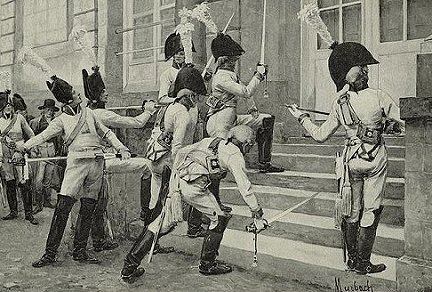



 Prussian cavalry grew from 1,000 sabers in the early XVII century to 6,000 by 1750.
During the Seven Years War it was decisive in a number of victorious battles, both by bold
charges and enveloping operations. In several occasions
it even prevented disaster by covering army retreats. The cavalry was probably the most
vaunted arm of the Prussian army until 1800.
Under a leader as renowned as Friedrich Wilhelm, Freiherr von Seydlitz (1721-1773), the Prussian cavalry achieved the nearest to a state
of perfection that it was ever going to. So great was its reputation in the Seven Years' War
that Napoleon made a special point of warning his men at the
beginning of the 1806 campaign to beware of the Prussian cavalry.
Prussian cavalry grew from 1,000 sabers in the early XVII century to 6,000 by 1750.
During the Seven Years War it was decisive in a number of victorious battles, both by bold
charges and enveloping operations. In several occasions
it even prevented disaster by covering army retreats. The cavalry was probably the most
vaunted arm of the Prussian army until 1800.
Under a leader as renowned as Friedrich Wilhelm, Freiherr von Seydlitz (1721-1773), the Prussian cavalry achieved the nearest to a state
of perfection that it was ever going to. So great was its reputation in the Seven Years' War
that Napoleon made a special point of warning his men at the
beginning of the 1806 campaign to beware of the Prussian cavalry.
 In 1757 at Rossbach the Prussian army (22,000 men) under Frederick the Great defeated the
French and German armies (54,000 men) under Marshal Prince de Soubise.
In 1757 at Rossbach the Prussian army (22,000 men) under Frederick the Great defeated the
French and German armies (54,000 men) under Marshal Prince de Soubise.
 During the Napoleonic Wars the Prussian cavalry enjoyed several notable
successes against the enemy. One of the greatest cavalry charges of the
Napoleonic Wars was made by the Prussians in the battle of Leipzig.
During the Napoleonic Wars the Prussian cavalry enjoyed several notable
successes against the enemy. One of the greatest cavalry charges of the
Napoleonic Wars was made by the Prussians in the battle of Leipzig.
 Photo: Prussian light cavalry sabre from MilitaryHeritage
Photo: Prussian light cavalry sabre from MilitaryHeritage  According to contracts between 1803 and 1817, horses bought for the cavalry
should have had a minimum height at the withers:
According to contracts between 1803 and 1817, horses bought for the cavalry
should have had a minimum height at the withers: Picture: squadron of Prussian cavalry according
to instructions issued in 1812 (Russian Campaign).
Picture: squadron of Prussian cavalry according
to instructions issued in 1812 (Russian Campaign).
 Fig. 123:
Fig. 123: 
 Left: officer and private of Garde du Corps in 1806 ?, picture by Bryan Fosten.
Left: officer and private of Garde du Corps in 1806 ?, picture by Bryan Fosten. Picture: Normal-Dragoner-Eskadron in 1810. Picture by Knotel.
Picture: Normal-Dragoner-Eskadron in 1810. Picture by Knotel.
 The Guard Uhlan Regiment was formed from several smaller units:
The Guard Uhlan Regiment was formed from several smaller units:
 Left: Brandenburg Cuirassier Regiment in 1809, by Knotel.
From left to right:
Left: Brandenburg Cuirassier Regiment in 1809, by Knotel.
From left to right: 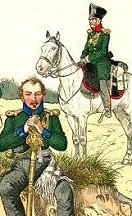 Right: Squadron of volunteer-jagers attached to the Brandenburg Cuirassier Regiment
1813, picture by Knotel
Right: Squadron of volunteer-jagers attached to the Brandenburg Cuirassier Regiment
1813, picture by Knotel

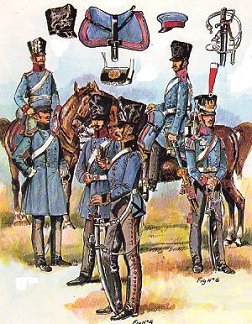 Left: Dragoon of the 6th Regiment in parade outfit in 1806.
Picture by Vuksic, Croatia.
Left: Dragoon of the 6th Regiment in parade outfit in 1806.
Picture by Vuksic, Croatia.
 The Prussian dragoons wore light blue (or blue) Kollet.
The Prussian dragoons wore light blue (or blue) Kollet.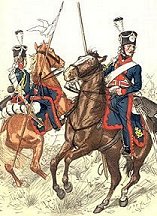
 Left: Regiment of Towarzysze (Towarczys) in 1806, picture by Knotel.
Left: Regiment of Towarzysze (Towarczys) in 1806, picture by Knotel.
 Left: Prussian hussars in 1806.
Picture by Knotel. From left to right:
- von Prittwitz Hussars (1806),
Left: Prussian hussars in 1806.
Picture by Knotel. From left to right:
- von Prittwitz Hussars (1806),  Right: detachment of Volunteer-Jagers of 1st Silesian Hussars in 1813.
Picture by Knotel.
Right: detachment of Volunteer-Jagers of 1st Silesian Hussars in 1813.
Picture by Knotel.
 The Prussian hussars were armed with curved sabers and carbines. Pistols were carried by NCOs
and trumpeters.
The Prussian hussars were armed with curved sabers and carbines. Pistols were carried by NCOs
and trumpeters.
 One regiment stood out above the others. It dressed in black and took as its badge a skull.
The regiment became known as the Death's Head Hussars and struck fear into the enemy for
many years. It was the 1st Life Hussar Regiment (1. Leib-Husaren-Regiment)
One regiment stood out above the others. It dressed in black and took as its badge a skull.
The regiment became known as the Death's Head Hussars and struck fear into the enemy for
many years. It was the 1st Life Hussar Regiment (1. Leib-Husaren-Regiment)
 The 1st and 2nd Life Hussars (Leib-Husaren) did wear the "Totenkopf" on their shakos.
There is however disagreement to the badge painted on
the shako cover. The well-known illustrator Knotel has the shako-covers painted
with the full skull and crossbones.
The 1st and 2nd Life Hussars (Leib-Husaren) did wear the "Totenkopf" on their shakos.
There is however disagreement to the badge painted on
the shako cover. The well-known illustrator Knotel has the shako-covers painted
with the full skull and crossbones.
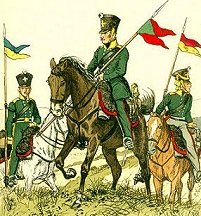
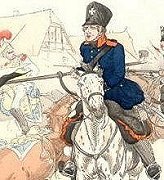 Left: detachment of volunteer jagers attached to Silesian Landwehr
Cavalry Regiment in 1813-1815. Picture by Knotel.
Left: detachment of volunteer jagers attached to Silesian Landwehr
Cavalry Regiment in 1813-1815. Picture by Knotel.
 The Landwehr cavalry was considered light cavalry.
The Landwehr cavalry was considered light cavalry.
